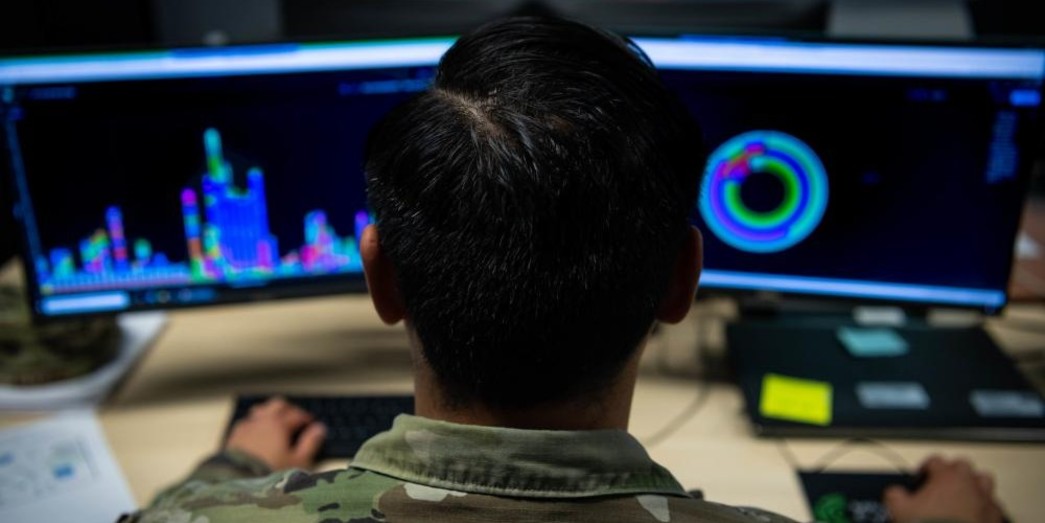Key takeaways and highlights from our latest annual report
Message From the Director

Mike Madsen, Acting DIU Director
Last year, the Defense Innovation Unit (DIU) celebrated its seventh year of accelerating commercial technology adoption across the Department of Defense (DoD). Launched as an experiment in 2015, DIU is now a proven business model for prototyping and acquiring leading-edge technology. In Fiscal Year (FY) 2022, DIU successfully transitioned 17 technology solutions to defense and civilian agency end-users, equating to $1.3B in contract award ceiling. The volume of transitions in FY 2022 is also the greatest we have seen in a single fiscal year, and more than double the eight transitions we saw in FY 2021.
The core of DIU operations continues to be fueled by our Commercial Solutions Opening process leveraging the Other Transaction “OT” authority, and a commitment to being a “fast follower” of commercial technology. In fact, we provided $4.9 B of total value in production OT contract ceiling to commercial companies since 2016, including most to nontraditional and first-time DoD customers.
Our portfolios focus on leveraging technology from six areas: autonomy, artificial intelligence (AI) and machine learning, cyber, energy, human systems, and space to enable a modern and agile Joint Force.
Many of the wins from FY 2022 are a credit to the steady and ambitious leadership of Mike Brown, whose four years at the helm saw many accomplishments of impact, scale and thought leadership. We owe much of where we are today as an organization to his hard work and vision.
As we move further along into FY 2023, DIU remains dedicated to accelerating commercial solutions to our DoD and U.S. government partners, strengthening our national security innovation base by lowering the barriers to entry and providing recurring revenue to non-traditional companies. I hope this FY 2022 Annual Report conveys the breadth and depth of our work and the positive effect we, as an organization, on our national security.
- Mike Madsen
FY22 In Review
Technologies We Are Prototyping
DIU is efficiently integrating commercial technology and methodologies into the DoD to enable a modern and agile Joint Force. We are helping to build enduring advantages by growing and strengthening our national security innovation base and transforming our military capabilities and capacity.
DIU has 103 active projects across our six technology portfolios. The following is a snapshot of our ongoing initiatives, which are aimed at creating outsized impact and scale across the Department as well as the whole-of-government.
We are:
Facilitating scalable, persistent awareness of position, navigation, and timing disruptions across the globe.
Position, navigation, and timing technology, or PNT, signals that inform GPS satellites to direct precision-guided munitions are similar to the ones that allow smartphone users to navigate the roadways, making it an essential capability for private citizens and military operators alike. Although a critical infrastructure, it is vulnerable to deception and manipulation. In the fall of 2021, DIU launched the Harmonious Rook prototype to map these GPS disruptions patterns using commercial data to identify, classify, and attribute threats.
Delivering enhanced visibility of the cyber threat landscape.
In today’s fragmented digital battlefield, governments often leverage non-state proxies to conduct cyber attacks. Historically, DoD has lacked visibility into such threats from both commercial telemetry data and nontraditional cyber data sources. Industry sources estimate that commercial cybersecurity providers already collect over 85% of available cyber threat data, which could fill critical gaps in the Department's cyber threat landscape.
Since 2019, USCYBERCOM’s Cyber National Mission Force (CNMF), and the Service cyber components have partnered with DIU to develop a growing suite of solutions. The DoD is now able to augment existing threat intelligence feeds with available commercial data.

Cyber warfare: The silent hunt (Source: DVIDS)
Leveraging AI to revolutionize talent discovery across the DoD.
In June 2021, DIU partnered with U.S. military service components to prototype an on-demand talent optimization platform—GigEagle—that leverages AI/ML methodologies to collect and connect DoD’s unique mission needs with available experts in the Guard and Reserve components.
Working with the Air Force on aircraft that can optimize cargo and tanker operations for the DoD.
The Air Force Operational Energy Office (SAF/IEN) partnered with the DIU, NASA, and commercial industry to prototype a concept of design (CoD) for an advanced aircraft configuration that provides at least 30% more aerodynamic efficiency compared to traditional aircraft models. DIU is currently in the process of competitively down-selecting prospective vendors for this concept of design effort.

Early Blended Wing Body concept design for NASA (Source: NASA)
Constructing a scalable, resilient, and responsive communications infrastructure.
Legacy ground and space communications systems rely on old technology, inefficient bandwidth allocations, as well as bespoke or proprietary data architectures. Altogether, these attributes inhibit true communications resiliency. DIU’s HSA program seeks to address this by providing global, ubiquitous, and secure internet connectivity throughout the space domain for commercial, civil, and military users, including allies and partners.
Disrupting illicit and adversarial cryptocurrency transactions.
In today’s digitized world, nearly every aspect of commercial and political statecraft is vulnerable to disruption, theft, or manipulation. The emergence of cryptocurrencies, in particular, is making it easier to monetize breaches in network security. To address this rising national security threat, USCYBERCOM came to DIU to prototype a solution that is capable of tracing cryptocurrency wallets to individuals and illuminating illicit networks using transaction data, specifically for actions targeted against U.S. government and military interests.

The Ascent AeroSystems Spirit is a coaxial UAV with a wide range of payloads, power sources, and launch methods that can adapt to diverse mission requirements. (Source: Ascent AeroSystems)
Providing new counter-UAS solutions for military installations.
In June 2021, DIU finalized a $99M contract with Anduril to make C-UAS available across the DoD and other U.S. agencies. Within 90 days of issuing the contract, three government entities made more than $35M in purchases.
Adapting wearable devices to detect chemical exposure.
Inadvertent exposure to chemical warfare agents presents a concern to civilian and military first responder communities, who may be required to enter environments where similar hazards are present. To address this, DIU and the Defense Threat Reduction Agency (DTRA) launched the Detecting Indicators of Chemical Exposure (DICE) program in 2020 and are currently prototyping chemical detection solutions through Philips Healthcare and PercuSense.
Accelerating DoD’s battery standardization and adoption.
DIU is partnering with the Office of the Secretary of Defense, the U.S. Army’s Combat Capabilities Development Command (DEVCOM) Ground Vehicle Systems Center (GVSC), and the Department of the Navy Operational Energy to accelerate battery standardization and platform electrification within the DoD by aligning defense battery requirements to commercial electric vehicle battery standards.

Jumpstart for Advanced Battery Standardization (JABS) project example. (Source: GM DefenseLLC/PRNewswire)
Transforming communication devices across the DoD.
Communication is essential for conducting military operations. This year, DIU launched two projects with two DoD partners to transform the way the DoD employs tactical communications for use with intelligence teams and the U.S. Coast Guard.
Initiating prototypes of high-power density fuels to enable future DoD missions.
Current spacecraft propulsion systems, whether powered by chemical or solar energy, will not meet requirements of future DoD space operations. Nuclear propulsion and power solutions are well-suited to these types of missions as they are able to move large masses at interplanetary distances. Accordingly, in FY 2022, DIU initiated a new project — Nuclear Advanced Propulsion and Power project— to prototype nuclear propulsion solutions for small and medium satellites; appropriate technologies are nuclear decay and fusion.
Stay Connected
The success of DIU's mission relies on engaging commercial companies across critical emerging technology sectors. We invite you to sign up for our email list and follow us on social media to receive updates on the latest DIU news as well as new project opportunities.
Prior DIU Annual Reports:
*Note: In prior annual reports, we based our metrics and performance on calendar year data. Starting in FY 2021, DIU will present metrics and performance on a fiscal year basis. This shift will enable us to better align with DoD and Congressional funding cycles.



